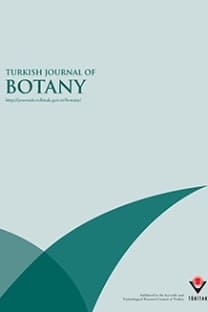Pollen viability and meiotic abnormalities in brome grasses (Bromus L., Section Ceratochloa) from Argentina
Pollen viability and meiotic abnormalities in brome grasses (Bromus L., Section Ceratochloa) from Argentina
___
- Armstrong KC (1991). Chromosome evolution of Bromus. In: Tsuchiya T, Gupta PK, editors. Chromosome Engineering in Plants: Genetics, Breeding, Evolution. Part B. Amsterdam, the Netherlands: Elsevier, pp. 366-377.
- Carputo D, Camadro EL, Peloquin SJ (2006). Terminology for polyploids based on cytogenetic behavior: consequences in genetics and breeding. Plant Breeding Reviews 26: 105-124.
- Gutiérrez HF, Pensiero JF (2012). Bromus L. In: Zuloaga FO, Rúgolo ZE, Anton AM, editors. Monocotyledoneae, Poaceae: Pooideae. Flora vascular de la República Argentina. Córdoba, Argentina: Gráficamente ediciones, pp. 33-56 (in Spanish).
- Hall BM (1955). Genetic analysis of interspecific hybrids in the genus Bromus, section Ceratochloa. Genetics 40: 175-192.
- Itria CD (1958). Identificación de algunas gramíneas pampeanas por sus caracteres vegetativos. Revista Argentina de Agronomía 25: 81-84 (in Spanish).
- Klos J, Sliwinska E, Kula A, Golczyk H, Grabowska-Joachimiak A, Ilnicki T, Szostek K, Stewart A, Joachimiak AJ (2009). Karyotype and nuclear DNA content of hexa-, octo-, and duodecaploid lines of Bromus subgen. Ceratochloa. Genet Mol Biol 32: 528-537.
- Langer RHM, Wilson D (1965). Environmental control of cleistogamy in prairie grass (Bromus unioloides H.B.K.). New Phytol 64: 80-85.
- Leofanti GA, Camadro EL, Echeverría MM, Alonso SI (2013). Anormalidades meióticas en especies nativas del género Bromus (Secc. Ceratochloa) de la Argentina. Journal of Basic and Applied Genetics 23 (Suppl. 1): 78 (in Spanish).
- Massa AN, Jensen KB, Larson SR, Hole DJ (2004). Morphological variation in Bromus sect. Ceratochloa germplasm of Patagonia. Can J Botany 82: 136-144.
- Naranjo CA (1992). Estudios biosistemáticos en especies de Bromus (Sección Ceratochloa, Poaceae). Sistemas reproductivos y barreras de aislamiento. Darwiniana 31: 173-183 (in Spanish).
- Pavlick LE, Anderton LK. (2007). Bromus. Grass Manual on the Web. Available online at http://herbarium.usu.edu/treatments/ bromus.htm.
- Peterson PM, Planchuelo AM (1998). Bromus catharticus in South America (Poaceae: Bromeae). Novon 8: 53-60.
- Planchuelo AM (1991). Estudios sobre el complejo Bromus catharticus (Poaceae) I. Evaluación estadística de los caracteres taxonómicos. Kurtziana 21: 243-257 (in Spanish).
- Planchuelo AM (2006). A new combination in the Bromus catharticus complex (Poaceae: Bromeae Sect. Ceratochloa). SIDA Contributions to Botany 22: 555-560.
- Ragonese A, Marcó P (1941). Observaciones sobre la biología floral de la Cebadilla Criolla. Revista Argentina de Agronomía 8: 196-199 (in Spanish).
- Ragonese A, Marcó P (1943). Influencia del fotoperíodo sobre la formación de flores cleistógamas y chasmógamas en Cebadilla criolla. Revista Argentina de Agronomía 10: 178-185 (in Spanish).
- Reeves A, Tear J (2000). MicroMeasure for Windows. Version 3.3. Fort Collins, CO, USA: Colorado State University. Available online at http://www.colostate.edu/Depts/Biology/MicroMeasure.
- Stebbins GL (1945). The cytological analysis of species hybrids. II. Bot Rev 11: 463-486.
- Stebbins GL (1956). Cytogenetics and evolution of the grass family. Am J Bot 43: 890-905.
- Stebbins GL, Tobgy HA (1944). The cytogenetics of hybrids in Bromus. I. Hybrids within the section Ceratochloa. Am J Bot 31: 1-11.
- Williams WM, Stewart AV, Williamson ML (2011). Bromus. In: Kole C, editor. Wild Crop Relatives: Genomic and Breeding Resources, Millets and Grasses. Berlin, Germany: SpringerVerlag, pp. 15-30.
- Wolff R, Abbott L, Pistorale S (1996). Reproductive behavior of Bromus catharticus Vahl. (Cebadilla criolla) in natural and cultivated populations. Journal of Genetics and Breeding 50: 121-128.
- Wolff R, Abbott L, Pistorale S (2001). Reproductive strategy of Bromus catharticus Vahl. (Cebadilla criolla). Phenotypic plasticity in natural population progenies. Journal of Genetics and Breeding 55: 67-74.
- ISSN: 1300-008X
- Yayın Aralığı: 6
- Yayıncı: TÜBİTAK
Spatial and temporal patterns of benthic diatom flora in Lake Stechlin, Germany
Beáta SZABÓ, Judit PADISÁK, Lothar KRIENITZ, Peter CASPER, Csilla STENGER-KOVÁCS, Géza B. SELMECZY
Filipa MARTINS, İvo OLIVEIRA, Ana BARROS, Carla AMARAL, Sílvia AFONSO, Helena FERREIRA, José MOUTINHO-PEREIRA, Berta GONÇALVES
ERTUĞRUL SESLİ, ALFREDO VIZZINI
Reproductive biology of the critically endangered endemic plant Erodium somanum in Turkey
Beáta SZABÓ, Judit PADISAK, Géza B. SELMECZY, Lothar KRIENITZ, Peter CASPER, Csilla STENGER-KOVÁCS
Ertuğrul SESLİ, Alfredo VIZZINI
Gabriela Agustina LEOFANTI, Elsa Lucila CAMADRO
LÜTFİ BEHÇET, AHMET İLÇİM, YAKUP YAPAR
A novel phytoene synthase paralog from halophytic Salicornia confers salinity tolerance in plants
